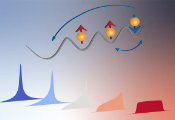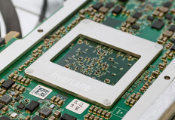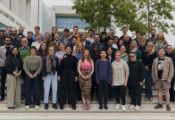Researchers Use Argonne X-Rays to Better Understand the Phases of a Quantum Material
June 26, 2025 -- Understanding the mysterious properties of materials requires the ability to precisely measure the atoms of those materials as they go through changes. For example, scientists are not certain why quantum materials become superconducting at low temperatures. To find out, they need the most advanced instruments available to catch the atoms in the act.
The Advanced Photon Source (APS), a U.S. Department of Energy (DOE) Office of Science user facility at DOE’s Argonne National Laboratory, is one such instrument. Or rather, it’s more than 70 such instruments, able to explore materials with a variety of X-ray techniques and, when needed, combine those techniques to deliver a more comprehensive result.
Recently a collaboration between DOE’s SLAC National Accelerator Laboratory and Argonne used the ultrabright X-ray beams of the APS to uncover tantalizing insights about strontium titanate, a material that was once used as a diamond substitute in jewelry and now has the potential to unlock our understanding of an array of quantum behaviors.
The research team built extremely thin, flexible strontium titanate membranes and, using a sample apparatus developed by the beamline staff, stretched it, in the process turning on what is known as a ferroelectric state. In that state, the material generates its own electric field, somewhat similar to how a permanent magnet generates its own magnetic field. APS X-ray beams were able to capture the movement of the ions in the material as it was repeatedly strained to “tune” the material in and out of a ferroelectric state.
“Our apparatus allows us to precisely control the strain placed on the material,” said Yongseong Choi, a physicist who works at the APS. “That and the combination of X-ray techniques we used gave us an extraordinary insight into the behavior of this material as it transitions through controlled phases.”
The team used two beamlines at the APS. They performed linear X-ray dichroism at beamline 4-ID-D to determine the change in the spacing between the atoms, and X-ray diffraction at beamline 6-ID-B to determine the strain on the material. Combining these results enabled the team to precisely track the arrangement of electrons in the material as its positively charged titanium ions were separated from its negatively charged oxygen ions, creating an electric field.
While the ability to turn on ferroelectricity — as well as superconductivity through the addition of impurities — makes strontium titanate promising for applications in next generation computing, data storage and superconducting devices, this well-known material also offers us a prototype to study fundamental quantum behaviors in a plethora of structurally similar materials.
What the research team found when they lowered the material temperature to cryogenic temperatures — lower than 200 degrees Fahrenheit below zero – was a transition into a quantum state. In this state, quantum fluctuations — random, temporary changes in energy levels — present themselves. At lower temperatures under applied strain strontium titanate began to shift to a state in which quantum fluctuations, rather than thermal motion, drove the order of nearby ions in the material.
Stretching the material is an excellent tuning parameter altering those quantum fluctuations. Introducing strain as a control element gives scientists more ways to explore the material’s properties. A better understanding of this transition could help researchers tailor strontium titanate and other quantum materials for different applications, such as microelectronic switches or capacitors.
“Our results hint that these quantum fluctuations are playing a role at lower temperatures when the quantum effect is more predominant than the classical effect in the transition,” said SLAC Postdoctoral Fellow Jiarui Li, who spearheaded the project.
In addition to the interesting result, the experiment showed that the combination of X-ray techniques and strain is a viable method for probing and tuning quantum materials. Strontium titanate is well-understood, according to Argonne Physicist Philip J. Ryan, and the team is looking forward to observing materials with more elusive properties.
Additionally, this experiment was one of the last performed at the APS before it underwent a comprehensive upgrade to increase the brightness of its X-ray beams. The upgraded APS, Ryan said, will be able to more precisely measure the movement and order of the ions, shedding more light on the nature of their quantum behaviors.
“The increased brightness of the APS X-ray beams will allow us to resolve the full picture,” Ryan said. “The integration of the improved beams, the sample environment and the combination of techniques available at the APS will make further breakthroughs with these materials possible.”




































